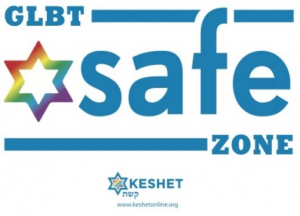
By Mira Sucharov

Readers who frequent the Soloway JCC in Ottawa may have noticed the “Keshet LGBTQ safe zone” stickers adorning the entrance and other high-traffic areas. Our community has come a long way towards wider and more public acceptance of the diversity of sexual orientations and gender identities that comprise our broad community. I feel good knowing that I’m raising my kids in a communal atmosphere where diversity is celebrated.
There have been other examples of recent attempts at inclusion. Members of the Ottawa Jewish community joined the local Keshet group in marching at Capital Pride last summer. I was proud to see that my own shul marched under the shul banner, a year after we invited Rabbi Steve Greenberg, an openly gay, Orthodox rabbi, to spend a shabbat with our community discussing issues around inclusion.
Several weeks ago, I spoke with Joy Ladin, another strong and inspiring LGBTQ voice in the North American Jewish community. Ladin, author of Through the Door of Life: A Jewish Journey Between Genders is a professor at Yeshiva University’s Stern College. I asked her what she thinks Jewish institutions can do for gays and lesbians, as well as for transgender individuals. Ladin told me about the Jewish Organization Equality Index — a recent project funded by the Schusterman foundation which surveyed American Jewish organizations about their policies of openness and inclusion, for which Ladin was on the advisory board.
“One of the things I always wonder,” Ladin told me, is, “am I safe?” Few people, she added, “want to be pigeonholed when they walk in.” She mentioned that “seeing a welcome policy, or an LGBT-friendly sticker, or an announcement for events that reflect LGBT interests,” can help instill a spirit of inclusion. Conversely, “if I walk in the door and everything I see reflects a hetero-normative idea of Jewish families, then I get nervous.”
Ladin helped me dig deeper into what it means to be inclusive. “If you really want to be inclusive,” she said, “then you have to do more than just tolerate people. You have to talk about them. The community has to discuss it. Do we know any of these folks?”
Ladin added that “There is much in secular Jewish life that is gendered: the men’s club, the women’s club. I identify as female, but I might not meet all your criteria: am I welcome?”
But there is another side to the inclusion coin, Ladin acknowledged. “I think a full process also means giving community members who are uncomfortable with transgender people to express their concerns.” By way of example, she described a scenario where someone might feel threatened by the sight of a transgender woman in a female washroom. The community needs to process what the transgender experience means.
The results of the Jewish Organization Equality Index survey can be found here (http://bit.ly/WMLxFf). While Canadian institutions were not surveyed, the Ottawa Jewish community may wish to take a look at the results as a point of discussion.
How, in the very gendered experience that is organized Judaism, can we expand the tent to include various expressions of sexual identity and gender identity? How can we do better at ensuring that our community is not just a community for straights, and is not just a community for those whose gender is experienced in conventional ways?
Are we ensuring that our youth groups are spaces where our community’s teens can engage in openand healthy discussions of sexuality? Are they free to “come out”? Or are our teens made to feel that to “come out” means to “exit” Jewish life? As they contemplate their Jewish future, will they realize that the chuppah is open to them? Will some shuls, conversely, see an exodus and others an increase in members as the next generation votes with the values of inclusion?
Making space for voices like Joy Ladin’s or Rabbi Steve Greenberg’s is a good start. Through sharing their own intense personal struggles, they are examples of steadfastness, openness, and inspiring leadership.
But we must ensure that the many individuals who aren’t lucky enough to possess the rare gifts of a Ladin or Greenberg — the ability to stand apart and be scrutinized, to shout the ethic of inclusion from the rooftops while they personally struggle with occupying two stripes on the diversity rainbow that mainstream Judaism often ignores, are nurtured and protected. Since, of course, a nurturing community is ultimately a better community for everyone.
A version of this article appears in the Ottawa Jewish Bulletin